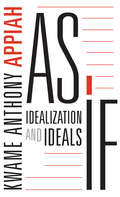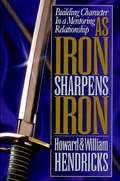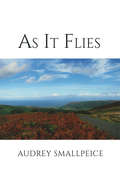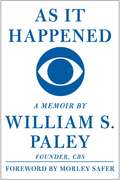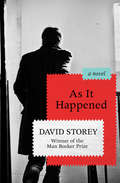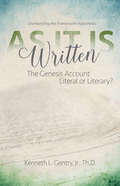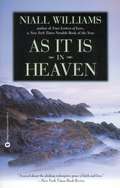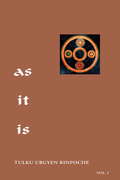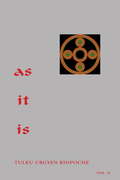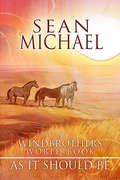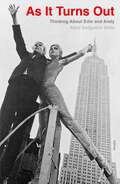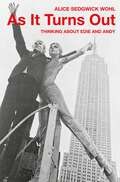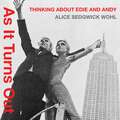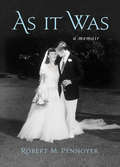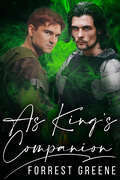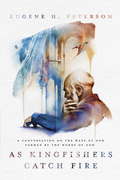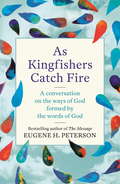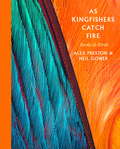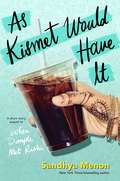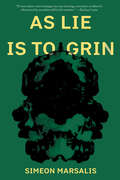- Table View
- List View
As If: Idealization and Ideals
by Kwame Anthony AppiahIdealization is a basic feature of human thought. We proceed “as if” our representations were true, while knowing they are not. Kwame Anthony Appiah defends the centrality of the imagination in science, morality, and everyday life and shows that our best chance for accessing reality is to open our minds to a plurality of idealized depictions.
As Iron Sharpens Iron: Building Character in a Mentoring Relationship
by Howard G. Hendricks William D. HendricksThink about the people who influenced your life most. Why did they do it? What did they do? How did they go about it? Answer these questions and you will be hooked on mentoring for the rest of your life. In As Iron Sharpens Iron, respected authors Howard and Bill Hendricks show that the most dramatic spiritual and personal growth often happens through the influence of a mentor. Rooted in biblical principles, this book is both a profound and practical guide to mentoring relationships for men. You'll learn how to: - Identify the kind of mentor you need - Maximize your mentoring relationship - Model your relationship after biblical examples - Grow through the shared wisdom of another believer - Influence others as you replicate the mentoring processWhether you are looking for a mentor or wish to mentor someone else, this book provides specific steps to begin the relationship and make the most of it.
As Is: A Novel
by Rachel Michael ArendsThe debut novel from the author of Help Yourself and Settling—a moving story of love, loyalty, and going on with life when there’s not much left to go on . . . Gwendolyn Golden and Armand Leopold are America’s go-to couple for home decorating tips, letting the cameras into their “So Perfect” house, “So Perfect” marriage, and “So Perfect” life. But when a picture of Armand kissing another man hits the newsstands, their “So Perfect” empire crumbles. While Armand deals with his very private life becoming very public, Gwen returns home to Riveredge, a quiet town where her father and sister still live . . . along with the guy who got away. After years of pretending, it’s time for Gwen to rebuild her life for real. Her first task is turning a new house into a home. But reconnecting with the man she once loved may be the most difficult challenge of all.
As It Flies
by Audrey SmallpeiceBritain in the 1970s offered fertile ground for those on a mission. For much of the decade, the country was crippled by the high price of oil, economic mismanagement and strikes. Written in the 1980s, this is the story of two individualists, Feral Windward, an artist and farmer, and Jamie Moray, a poet and healer, who meet by chance and develop an intense friendship based on their shared love of the natural world and mutual concern for the spiritual state of humanity. Inspired and encouraged by each other, Feral and Jamie propose to put their Christian faith and their talents to practical use. They set out on separate paths, buoyed by their strong sense of purpose and the support of a colourful group of friends as they abandon themselves to risk. At the poetic and mystical heart of the book Feral's farm on Exmoor endures as the sanctuary where she and friends gather at every opportunity.
As It Happened: A Memoir
by William S. PaleyWilliam S. Paley was a founder and chairman of CBS, one of the major television networks in the United States. Under his leadership, CBS introduced the first successful worldwide new broadcast. He fought against radio censorship, particularly in terms of news reporting about World War II. In the 1950s, he promoted Edward R. Murrow to be one of the newscasters for CBS News, starting a news dynasty. He led CBS into television, with CBS leading prime time broadcasting ratings from 1955 through 1976. He was also the owner of the N.Y. Yankees baseball team from 1964 to 1976.
As It Happened: A Novel
by David StoreyA wry and deeply affecting novel about a man's ruminations on art and death by the Man Booker Prize-winning author of This Sporting Life Matthew Maddox is an art historian and professor emeritus at the Drayburgh School of Fine Art. Nearing 70, his 3 sons are grown and his ex-wife, Charlotte, has remarried. After a failed suicide attempt in front of a moving train, Maddox attends art therapy classes in order to find new meaning in his life. Although he is isolated, Maddox does have his champions. Simone, his lover and partner, is returning shortly from an analysts' conference in Vienna. She has her own baggage, but Simone feels responsible for Maddox. Others who genuinely care about Maddox include his former mentor Daniel Viklund, whose wartime past fascinates Maddox; his older sister, Sarah; and his younger brother, Paul. There is also Eric Taylor, once his most promising student, now a convicted murderer, in whom Maddox sees echoes of his own life. An unabashed novel of mental illness, As It Happened tells of the prisons in which we find ourselves, the anxieties that exert their hold, and the desperate search for purpose in how we live and how we die.
As It Is Written: The Genesis Account Literal or Literary?
by Kenneth Gentry Jr.The framework hypothesis or literary framework view has grown in acceptance as more readers of Scripture place “science” as the authority over the interpretation of God’s Word. By re-interpreting Genesis, this view encourages Christians to disregard the plainly shared timeline of creation and instead consider it as merely figurative or poetic rather than historical and accurate. Kenneth Gentry carefully defines the framework hypothesis, while tracing its historical origins and purpose. This provides a helpful introduction both for those who know the framework hypothesis as well as any hearing the term for the first time.<P><P> This important study:<P> - Presents strong exegetical arguments for the six-day creation approach to Genesis<P> - Illustrates the traditional interpretation of Genesis, a survey of exegetical arguments, and responses to alleged problems<P> - Demonstrates the flaws in the framework argument.<P> This book presents in a simple but clear presentation the basic argument for a six-day literal interpretation of Genesis 1. It also explains and rebuts the framework hypothesis, which is a leading view in evangelical academic circles. This book is aimed at intelligent laymen, though with the academic reader in mind, with definitions of technical terms where they are necessary and Greek and Hebrew words transliterated.
As It Is in Heaven
by Niall WilliamsA man content to let life pass him by, schoolteacher Stephen Griffin is about to experience a miracle. For a string quartet from Venice has arrived in County Clare and, with it, worldly and beautiful violinist Gabriella Castoldi, who inspires love in the awkward Stephen. Although the town's blind musician senses its coming, the greengrocer welcomes its sheer joy, and Stephen's ailing father fears its power, none could have foreseen how the magical force of passion would change not only Stephen's life but, in the most profound and startling ways, the lives of everyone around them. A tale of dreams, life, and love, AS IT IS IN HEAVEN affirms the acclaimed author of Four Letters of Love as one of today's master storytellers.
As It Is, Volume 1
by Erik Pema Kunsang Rinpoche Urgyen Tulku, Rinpoche Urgyen TulkuThe teachings presented in As It Is, Volume I are primarily selected from talks given by the Dzogchen master, Tulku Urgyen Rinpoche, in 1994 and 1995, during the last two years of his life. The unambiguous Buddhist perception of reality is transmitted in profound, simple language by one of the foremost masters in the Tibetan tradition. Dzogchen is to take the final result, the state of enlightenment itself, as path. This is the style of simply picking the ripened fruit or the fully bloomed flowers. Tulku Urgyen's way of communicating this wisdom was to awaken the individual to their potential and reveal the methods to acknowledge and stabilize that prospective. His distinctive teaching style was widely known for its unique directness in introducing students to the nature of mind in a way that allowed immediate experience. This book offers the direct oral instructions of a master who inspired admiration, delight in practice, and deep trust and confidence in the Buddhist way.From the Trade Paperback edition.
As It Is, Volume 2
by Erik Pema Kunsang Marcia Binder Schmidt Rinpoche Urgyen Tulku, Rinpoche Urgyen TulkuThe teachings presented in As It Is, Volume II are primarily selected from talks given by the Dzogchen master, Tulku Urgyen Rinpoche, in 1994 and 1995, during the last two years of his life. The unambiguous Buddhist perception of reality is transmitted in profound, simple language by one of the foremost masters in the Tibetan tradition. Dzogchen is to take the final result, the state of enlightenment itself, as path. This is the style of simply picking the ripened fruit or the fully bloomed flowers. Tulku Urgyen's way of communicating this wisdom was to awaken the individual to their potential and reveal the methods to acknowledge and stabilize that prospective. His distinctive teaching style was widely known for its unique directness in introducing students to the nature of mind in a way that allowed immediate experience. This book offers the direct oral instructions of a master who inspired admiration, delight in practice, and deep trust and confidence in the Buddhist way.From the Trade Paperback edition.
As It Is, Volume I
by Tulku Urgyen RinpocheProfound teachings on the path of Dzogchen by a realised master
As It Is, Volume II
by Tulku Urgyen RinpocheThe collection of teachings presented in As It Is, Volume II, is selected fromtalks given by the Tibetan meditation master Tulku Urgyen Rinpoche between1994 and 1995. The emphasis in Volume I was on the development stagepractice; Volume II focuses primarily on the completion stage.Tulku Urgyen Rinpoche was someone with extraordinary experience andrealization, a fact known throughout the world. It is evident to everyonethat he was unlike anyone else when it came to pointing out the nature ofmind, and making sure that people both recognized it and had some actualexperience.-Khenchen Thrangu RinpocheTulku Urgyen Rinpoche was an incredible master, one who was both learnedand accomplished. The great masters of this time-the 16th Karmapa,Dudjom Rinpoche and Dilgo Khyentse Rinpoche-all venerated him as oneof their root gurus and a jewel in their crown ornament. He was someone whoachieved the final realization of the Great Perfection.-Orgyen Tobgyal RinpocheThe difference between buddhas and sentient beings is that sentient beingsare busy fabricating. Our self-existing wakefulness has fallen under the powerof being altered. As long as we continue to do so, we will wander in samsara.Rather than doing that, we need to recognize the nature of mind. I amexplaining this here to give you the idea of how things are. The next step isfor you to experience. Intellectual understanding is not enough. You need toactually taste and realize this self-existing wakefulness. Train till it becomesuninterrupted
As It Should Be (Windbrothers #2)
by Sean Michael2nd EditionA Windbrothers CollectionSet in the sweeping Windbrothers' world, where magic users and their sworn mates find each other through a process of trial and error, these stories, which take place long before the events in Desert, explore the different ways that ba'chi and hi'icha come together to become ki'ita. For every magic user, there is a grounding force to steady him, and neither half of the pair feels whole until he finds his destined lover. Some mates discover each other with relative ease, while others have a harder time uniting with their designated partners, and the world they live in can be accepting, cruel, or even indifferent. From a shape-shifter with a secret to a pair of twins who think they'll never find their lover, Sean Michael gives us a lot to love, just as it should be, in these stories sure to tug at your heart.1st Edition published by Torquere Press, 2006.
As It Turns Out: Thinking About Edie and Andy
by Alice Sedgwick WohlThe story of the model, actress, and American icon Edie Sedgwick is told by her sister with empathy, insight, and firsthand observations of her meteoric life.As It Turns Out is a family story. Alice Sedgwick Wohl is writing to her brother Bobby, who died in a motorcycle accident in 1965, just before their sister Edie Sedgwick met Andy Warhol. After unexpectedly coming across Edie’s image in a clip from Warhol’s extraordinary film Outer and Inner Space, Wohl was moved to put her inner dialogue with Bobby on the page in an attempt to reconstruct Edie’s life and figure out what made Edie and Andy such iconic figures in American culture. What was it about Andy that enabled him to anticipate so much of contemporary culture? Why did Edie draw attention wherever she went? Who exactly was she, who fascinated Warhol and captured the imagination of a generation? Wohl tells the story as only a sister could, from their childhood on a California ranch and the beginnings of Edie’s lifelong troubles in the world of their parents to her life and relationship with Warhol within the silver walls of the Factory, in the fashionable arenas of New York, and as projected in the various critically acclaimed films he made with her. As Wohl seeks to understand the conjunction of Edie and Andy, she writes with a keen critical eye and careful reflection about their enduring impact. As It Turns Out is a meditation addressed to her brother about their sister, about the girl behind the magnetic image, and about the culture she and Warhol introduced.
As It Turns Out: Thinking About Edie and Andy
by Alice Sedgwick WohlThe story of model, actress, and American icon Edie Sedgwick as told by her sister with empathy, insight and firsthand observations of her meteoric life.In As It Turns Out, Alice Sedgwick Wohl writes to her brother Bobby, who died in a motorcycle accident in 1965, just before their sister Edie Sedgwick met Andy Warhol. After unexpectedly coming across Edie's image in a clip from Warhol's extraordinary film Outer and Inner Space, Wohl was moved to put her inner dialogue with Bobby on the page in an attempt to reconstruct Edie's life and figure out what made Edie and Andy such iconic figures in American culture. What was it about Andy that enabled him to anticipate so much of contemporary culture? Why did Edie draw attention wherever she went? Who exactly was she, who fascinated Warhol and captured the imagination of a generation?Wohl tells the story as only a sister could, from their childhood on a California ranch and the beginnings of Edie's lifelong troubles in the world of their parents to her life and relationship with Warhol within the silver walls of the Factory, in the fashionable arenas of New York, and as projected in the various critically acclaimed films he made with her. As Wohl seeks to understand the conjunction of Edie and Andy, she writes with a keen critical eye and careful reflection about their enduring impact. As It Turns Out is a meditation addressed to her brother about their sister, about the girl behind the magnetic image, and about the culture she and Warhol introduced.
As It Turns Out: Thinking About Edie and Andy
by Alice Sedgwick WohlWe think we know Edie Sedgwick, Warhol muse, Factory superstar, icon of the 1960s, a comet who flamed out too soon.As It Turns Out is Edie's story told from a different point of view - that of her older sister, Alice. As Edie's fame was in the ascendant, Alice was living a completely different life in Manhattan, far away from the Factory and the Chelsea scene. Then, many years later, chancing on Edie's image in a clip from Andy's film Outer and Inner Space, Alice was moved to reconsider Edie's life and try to figure out what made Edie and Andy such iconic figures whose image and collaborative work have endured for decades. How did he anticipate so much of contemporary culture? Who exactly was Edie, that she fascinated Warhol and captured the imagination of a generation? Wohl tells Edie's story, from her privileged and isolated childhood on a California ranch to her escape first to Boston and then to Manhattan, where in 1965 she had her first fateful encounter with Warhol. As It Turns Out is a meditation on the girl behind the irresistible image, and on the culture that she and Warhol ignited. Throughout this thoughtful, truthful reappraisal of Edie's life, Alice Sedgwick Wohl tries to find a deeper answer to the question: What was the thing about Edie?
As It Was: A Memoir
by Robert M. Pennoyer"Robert M. Pennoyer was born into a storied family - his maternal grandfather was the legendary J. P. Morgan. His irresistible memoir traces his sheltered childhood on the Gold Coast of Long Island; an adolescence overshadowed by the gathering clouds of World War II; and a young adulthood that survived one of the decisive engagements of the Pacific Theater - Iwo Jima. The author gives us as well a heartwarming account of a romance that blossomed into a lifelong matrimonial partnership and a close family life, tested nonetheless by crisis. And he chronicles a distinguished career, the early part of which was spent in the service of President Eisenhower and the latter part in private law practice and pro bono work. As It Was begins in an era of unprecedented wealth and privilege for some and great misery and poverty for others, - one that Mark Twain lampooned as the "Gilded Age," and ends, coming in effect full circle, in our own era of the One Per Cent, as the income chasm in America reopens. What divides these periods, and is so impressively portrayed here, is the rise of American Progressivism led by the two Roosevelts. Most importantly, this book is itself a demonstration of the values that boosted America on its path to greatness and for which no finer exemplar could be found than its author. It bespeaks a belief in democracy that is passionate and unshakable, and builds on a deep appreciation of the institutions that enable it. The spirit that flows through these pages may be modest, but it is also filled with an irrepressible optimism and a faith in simple values that are both uplifting and marvelously contagious. As It Was is a lesson in a life well lived, and a tonic for dark and troubled times."-- Scott Horton, author of Lords of Secrecy: The National Security Elite and America's Stealth Warfare (2015), contributing editor,Harper's Magazine.
As King's Companion
by Forrest GreeneJaime is the fourth son of the Prince of the Heighlands. Always an outsider in his family, Jaime seems unable to ever please his father, no matter how he tries. He longs to be a fighter, a hunter, anything other than the role his father has mapped out for him: future steward to his oldest brother.But Jaime’s set path in life is overturned when the consequences of an indiscretion on his part prove to be the final straw for his father. Infuriated, Prince Halden sends Jaime away from the Heighlands, the only home Jaime has ever known, to serve at the court of the powerful and despised king of Leilani. Alone in a much more sophisticated society than he is used to, Jaime must maneuver to find his way ... and struggle to understand his feelings about the handsome King Alder of Leilani, to whom he has sworn fealty.Alder has much on his mind. Fighting a war he can’t end and can’t afford to lose, his widowed state is of far less import. Nonetheless, his Councilors are demanding he choose a Companion -- a man to please his bed -- as is expected of a widowed Leilani king with heirs. It is a choice he is in no hurry to make. The war and losses on the battlefield are of far greater concern, and the arrival of a disgraced prince from the least loyal part of his kingdom is a minor and unwanted distraction.Until Jaime walks into his court. For the first time in his life, Alder feels a genuine surge of lust for a man. But it’s a hopeless attraction. No Heighlander would admit to wanting another man, ever.Jaime wants to fight in the war. Alder wants to make love to him. Can they both possibly get what they want?
As Kingfishers Catch Fire: A Conversation on the Ways of God Formed by the Words of God
by Eugene H. PetersonLiving Out the Word Made Flesh “Sixty years ago I found myself distracted,” Eugene Peterson writes. “A chasm had developed between the way I was preaching from the pulpit and my deepest convictions on what it meant to be a pastor.” And so began Peterson’s journey to live and teach a life of congruence—congruence between preaching and living, between what we do and the way we do it, between what is written in Scripture and how we live out that truth. Nothing captures the biblical foundation for this journey better than Peterson’s teachings over his twenty-nine years as a pastor. As Kingfishers Catch Fire offers a never-before-published collection of these teachings to anyone longing for a richer, truer spirituality. Peterson’s strikingly beautiful prose and deeply grounded insights usher us into a new understanding of how to live out the good news of the Word made flesh. This is one man’s compelling quest to discover not only how to be a pastor but how to be a human being.
As Kingfishers Catch Fire: A Conversation on the Ways of God Formed by the Words of God
by Eugene Peterson'Sixty years ago I found myself distracted.' So begins the introduction to As Kingfishers Catch Fire. What follows is the record of the collaboration of pastor and congregation in acts of worship and a life together. What Eugene Peterson, for thirty years pastor of a Maryland church, discovered is that the pastor's life is much more than just the preaching. It is also made up of attending to the details in all the circumstances and relationships specific to a people and a place - prayers at a hospital bed, conversations with the elderly, small talk on a street corner. This collection of spiritual writings presents Peterson's distinctive approach designed to communicate to his congregation, and the reader, 'the full counsel of God.' Seven sections containing seven teachings, each expertly crafted to stir the biblical imagination. In these teachings, Peterson walks the reader through Scripture to bring fresh insight to familiar names such as Moses, David, Isaiah, Solomon, Peter, Paul, and John of Patmos.
As Kingfishers Catch Fire: Birds & Books
by Neil Gower Alex Preston'Delightful . . . an original look at the literature inspired by Britain's birdlife' the Guardian, Best Nature Books of 2017'[The] pages light up with feathered magic' Evening StandardWhen Alex Preston was 15, he stopped being a birdwatcher. Adolescence and the scorn of his peers made him put away his binoculars, leave behind the nature reserves and the quiet companionship of his fellow birders. His love of birds didn't disappear though. Rather, it went underground, and he began birdwatching in the books that he read, creating his own personal anthology of nature writing that brought the birds of his childhood back to brilliant life. Looking for moments 'when heart and bird are one', Preston weaves the very best writing about birds into a personal narrative that is as much about the joy of reading and writing as it is about the thrill of wildlife. Beautifully illustrated and illuminated by the celebrated graphic artist Neil Gower, As Kingfishers Catch Fire is a book to love and to hold, to return to again and again, to marvel at the way that authors across the centuries have captured the endless grace and variety of birds. It will make you look at birds, at the world, in a newer, richer light.'A joyful and a wondrous book . . . Each bird illustrated by Gower in a mixture of gouache and watercolour that brings to mind both William Morris and Eric Ravilious' the Observer'I can see it under the Christmas tree of every family with a bird feeder and a copy of the RSPB Handbook . . . Preston captures his birds beautifully' The Times
As Kingfishers Catch Fire: Birds & Books
by Neil Gower Alex Preston'A magical book: an inimitable fusion of ornithology, literary anthology and autobiography.' Tom HollandWhen Alex Preston was 15, he stopped being a birdwatcher. Adolescence and the scorn of his peers made him put away his binoculars, leave behind the hides and the nature reserves and the quiet companionship of his fellow birders. His love of birds didn't disappear though. Rather, it went underground, and he began birdwatching in the books that he read, creating his own personal anthology of nature writing that brought the birds of his childhood back to brilliant life. Looking for moments 'when heart and bird are one', Preston weaves the very best writing about birds into a personal and eccentric narrative that is as much about the joy of reading and writing as it is about the thrill of wildlife. Moving from the 'high requiem' of Keats's nightingale to the crow-strewn sky at the end of Alan Garner's The Weirdstone of Brisingamen, from Ted Hughes's brooding 'Hawk in the Rain' to the giddy anthropomorphism of Jonathan Livingstone Seagull, this is a book that will make you look at birds, at the world, in a newer, richer light. Beautifully illustrated and illuminated by the celebrated graphic artist Neil Gower, As Kingfishers Catch Fire is a book to love and to hold, to return to again and again, to marvel at the way that authors across the centuries have captured the endless grace and variety of birds.'A joyful and a wondrous book' the Guardian
As Kismet Would Have It
by Sandhya MenonWill Dimple and Rishi find their happily ever after? Find out in this funny, romantic, endlessly charming enovella companion to the New York Times bestseller When Dimple Met Rishi!Dimple Shah has a lot of opinions about marriage, but they boil down to this: It’s not for her. Sure, she loves her boyfriend, Rishi, but why does she need to validate that with an institution that has historically never favored the woman? Why go through all that hassle? Rishi Patel deeply disagrees. He believes in the power that comes with combining love and tradition, and when the time comes, wants nothing more than to honor those things in a huge celebration with his friends and family. He knows Dimple loves him, but in hearing her rant about how marriage is a “construct of hegemonic masculinity” for the millionth time, a small, niggling part of him worries that it’s not the institution of marriage Dimple has a problem with; maybe it’s him. The two lovebirds find themselves at a philosophical impasse. Can they find a way to work it out, or does kismet have other plans?
As Large as Life: Dazzling Museum Displays (Fountas & Pinnell Classroom, Guided Reading Grade 5)
by Maggie DeSimoneNever Say No The word no isn't in Tim Quady's vocabulary. So when customers come to him and his creative team at Blue Rhino Studio, a model-making company, and ask for massive animal displays for their museums, the answer is always yes. They use their creativity and muster a lot of perseverance to build displays that will amaze every visitor who walks through the museum doors. NIMAC-sourced textbook
As Lie Is to Grin: A Novel
by Simeon MarsalisShortlisted for the 2017 Center for Fiction First Novel Prize€œSimeon Marsaliss As Lie Is to Grin is not a satire meant to teach us lessons, nor a statement of hope or despair, but something more visionarya portrait of a young mans unraveling, a depiction of how race shapes and deforms us, a coming-of-age story that is also a confrontation with American history and amnesia. The book achieves more in its brief span than most books do at three times the length. Zachary Lazar, author of I Pity the Poor Immigrant David, the narrator of Simeon Marsaliss singular first novel, is a freshman at the University of Vermont who is struggling to define himself against the white backdrop of his school. He is also mourning the loss of his New York girlfriend, whose grandfathers alma mater he has chosen to attend. When David met Melody, he lied to her about who he was and where he lived, creating a more intriguing story than his own. This lie haunts and almost unhinges him as he attempts to find his true voice and identity. On campus in Vermont, David imagines encounters with a student from the past who might represent either Melodys grandfather or Jean Toomer, the author of the acclaimed Harlem Renaissance novel Cane (1923). He becomes obsessed with the varieties of American architecture €œupon land that was stolen, and with the universitys past and attitudes as recorded in its newspaper, The Cynic. And he is frustrated with the way the Internet and libraries are curated, making it difficult to find the information he needs to make connections between the universitys history, African American history, and his own life. In New York, the previous year, Melody confides a shocking secret about her grandfathers student days at the University of Vermont. When she and her father collude with the intent to meet Davids mother in Harlemcraving what they consider an authentic experience of the black worldtheir plan ends explosively. The title of this impressive and emotionally powerful novel is inspired by Paul Laurence Dunbars poem €œWe Wear the Mask (1896): €œWe wear the mask that grins and lies . . .
